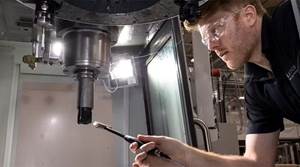Moving CAM To The Shop Floor
Conventional wisdom has it that CAD/CAM is something that happens in an office somewhere--indeed anywhere other than the shop floor. The notion of operators generating complex 3D tool path right there in the shop is simply not embraced by very many companies, and certainly not die and mold shops that must deal with themost challenging geometry on a daily basis.
Share





Conventional wisdom has it that CAD/CAM is something that happens in an office somewhere--indeed anywhere other than the shop floor. A certain level of shop floor programming is tolerated with CNCs so equipped, or perhaps some simple G-code typed in at the operator's panel. But the notion of operators generating complex 3D tool path right there in the shop is simply not embraced by very many companies, and certainly not die and mold shops that must deal with the most challenging geometry on a daily basis.
An English CAD/CAM developer, Delcam International (Birmingham, U.K.), is out to change that notion, however, with a product concept that leaves the complex creation of geometry in the office, but puts the creation of tool path in the hands of those who understand the machining process best of all, those who practice machining on the shop floor.
If that name, Delcam, doesn't quite ring a bell, it's because the company has until recently kept a rather low profile in the U.S. It's a different story in Europe and other parts where the company's Duct5 CAD/CAM software is well regarded for its ability to deal with complex 3D geometry, which has made the system particularly applicable to die and mold makers. The company claims more than 3,000 users in over 40 countries, and current annual sales and services exceed $20 million. Delcam maintains its own job shop--making prototypes, molds, and precision parts--and thus has a working lab for practical development of their software.
That real-world experience was particularly advantageous in the development of PowerMill, the company's stand-alone CAM system. The basic concept of the product is to provide an easy-to-use yet robust tool just for creating tool path code. In operation, the idea is to pre-define all the necessary workpiece geometry in CAD, and then transfer that manufacturing-ready model to a CAM station where someone expert in machining practice can develop the part program.
The system makes it relatively easy for the programmer to work out a machining strategy, and to alter that strategy, or try out different options. In support of this sort of task, the system offers very fast calculation times for various tool movements. It also incorporates some interesting new program optimization tools. For instance, "silhouette machining" limits tool paths to the current outline of the workpiece so less time is spent cutting air. "Rest milling" restricts finishing cuts only to areas where material is known to remain from earlier operations. Finishing speeds can be improved by smoothing "join-up moves" at the ends of repetitive paths to avoid sudden changes in axis direction. Also, "projection finishing" allows machining paths to be projected toward or away from any point, line or plane, rather than simply running down a machine axis. This may be used to provide a more consistent step-over to improve surface finish, particularly when machining near vertical walls. And in all cases, the system offers very high-functioning gouge avoidance, taking into account the composite workpiece geometry, cutting tool and toolholder.
But it takes an experienced machinist to know how to make the most of these and other cutting strategies, which is precisely the point behind putting such a programming tool in the hands of people on the shop floor. Besides that, Delcam points out additional advantages, such as better utilization of human resources, both in the shop and in the CAD department. It also can lend a greater deal of flexibility as well as quality of work to both disciplines since each is freer to more fully apply their expertise at the moment it is required--if they have the appropriate tools for doing so.
But Delcam also cautions that moving CAM to the shop floor will take some time to become productive. It's a major cultural change for most shops, and more than a few human resources will have to be redirected in order to achieve a new equilibrium of people- and machine-power.--TLB
Related Content
How to Mitigate Chatter to Boost Machining Rates
There are usually better solutions to chatter than just reducing the feed rate. Through vibration analysis, the chatter problem can be solved, enabling much higher metal removal rates, better quality and longer tool life.
Read MoreContinuous Improvement and New Functionality Are the Name of the Game
Mastercam 2025 incorporates big advancements and small — all based on customer feedback and the company’s commitment to keeping its signature product best in class.
Read MoreThe Power of Practical Demonstrations and Projects
Practical work has served Bridgerland Technical College both in preparing its current students for manufacturing jobs and in appealing to new generations of potential machinists.
Read More6 Machine Shop Essentials to Stay Competitive
If you want to streamline production and be competitive in the industry, you will need far more than a standard three-axis CNC mill or two-axis CNC lathe and a few measuring tools.
Read MoreRead Next
Machine Shop MBA
Making Chips and Modern Machine Shop are teaming up for a new podcast series called Machine Shop MBA—designed to help manufacturers measure their success against the industry’s best. Through the lens of the Top Shops benchmarking program, the series explores the KPIs that set high-performing shops apart, from machine utilization and first-pass yield to employee engagement and revenue per employee.
Read MoreAMRs Are Moving Into Manufacturing: 4 Considerations for Implementation
AMRs can provide a flexible, easy-to-use automation platform so long as manufacturers choose a suitable task and prepare their facilities.
Read More




















